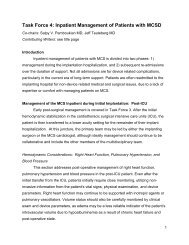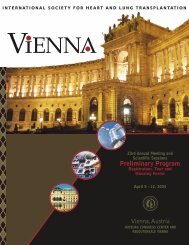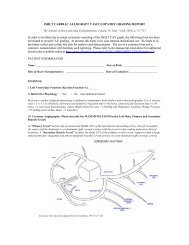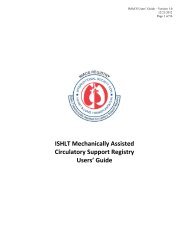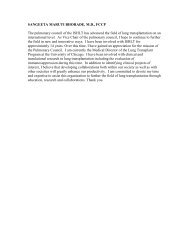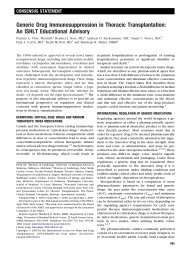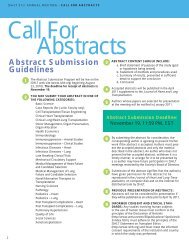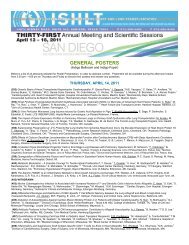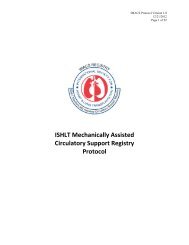Guidelines for the care of heart transplant recipients
Guidelines for the care of heart transplant recipients
Guidelines for the care of heart transplant recipients
You also want an ePaper? Increase the reach of your titles
YUMPU automatically turns print PDFs into web optimized ePapers that Google loves.
Costanzo et al.<br />
<strong>Guidelines</strong> <strong>for</strong> Heart Transplant Care<br />
933<br />
Level <strong>of</strong> Evidence: C.<br />
3. The following treatments are used to maintain adequate<br />
cardiac output and systemic blood pressure: (1) IV inotropes<br />
and vasopressors and (2) MCS.<br />
Level <strong>of</strong> Evidence: C.<br />
4. When AMR is suspected, EMB examination should be<br />
expanded to include immunohistochemistry stains <strong>for</strong><br />
complement split products and possibly antibody.<br />
Level <strong>of</strong> Evidence: C.<br />
5. Recipient serum should be screened <strong>for</strong> presence, quantity,<br />
and specificity <strong>of</strong> anti-donor (HLA) antibodies.<br />
Level <strong>of</strong> Evidence: C.<br />
6. Follow-up EMB should be per<strong>for</strong>med 1 to 4 weeks after<br />
initiation <strong>of</strong> <strong>the</strong>rapy and include immunohistochemistry<br />
examination.<br />
Level <strong>of</strong> Evidence: C.<br />
7. Adjustment <strong>of</strong> maintenance immunosuppressive <strong>the</strong>rapy<br />
may be considered. This can include increase in <strong>the</strong> dose<br />
<strong>of</strong> current immunosuppressive agent(s), addition <strong>of</strong> new<br />
agent(s), or conversion to different agent(s).<br />
Level <strong>of</strong> Evidence: C.<br />
Class IIb:<br />
1. Systemic anti-coagulation may decrease intravascular<br />
thrombosis in <strong>the</strong> <strong>heart</strong> allograft.<br />
Level <strong>of</strong> Evidence: C.<br />
2. Emergent re<strong>transplant</strong>ation may be considered if <strong>the</strong><br />
above measures do not restore acceptable <strong>heart</strong> allograft<br />
function, but outcomes in this situation are unfavorable.<br />
Level <strong>of</strong> Evidence: C.<br />
Topic 6: Management <strong>of</strong> Late Acute Rejection<br />
Recommendation <strong>for</strong> <strong>the</strong> Management <strong>of</strong> Late Acute Rejection:<br />
230,231<br />
Class I:<br />
1. Maintenance immunosuppression and <strong>the</strong> intensity <strong>of</strong><br />
clinical follow-up should be reevaluated after symptomatic<br />
or asymptomatic late acute <strong>heart</strong> allograft rejection.<br />
Level <strong>of</strong> Evidence: C.<br />
Class IIa:<br />
1. After <strong>the</strong> first year, EMB surveillance (eg, every 4–6<br />
months) <strong>for</strong> an extended period <strong>of</strong> time is recommended<br />
in patients at higher risk <strong>for</strong> late acute rejection, to<br />
reduce <strong>the</strong> risk <strong>of</strong> rejection with hemodynamic compromise,<br />
and to reduce <strong>the</strong> risk <strong>of</strong> death in African-American<br />
<strong>recipients</strong>.<br />
Level <strong>of</strong> Evidence: C.<br />
2. Repeated education on <strong>the</strong> critical importance <strong>of</strong> adherence<br />
to treatment, and early reporting <strong>of</strong> symptoms contribute<br />
to <strong>the</strong> prevention and early recognition <strong>of</strong> late<br />
acute rejection.<br />
Level <strong>of</strong> Evidence: C.<br />
3. Patients at low risk <strong>for</strong> late rejection do not appear to<br />
significantly benefit from indefinite EMB surveillance.<br />
The usefulness <strong>of</strong> long-term routine EMB should be<br />
evaluated against <strong>the</strong> risks and <strong>the</strong> costs <strong>of</strong> <strong>the</strong> procedure.<br />
Repeated EMB increase <strong>the</strong> probability <strong>of</strong> damage to <strong>the</strong><br />
TV apparatus and collection <strong>of</strong> non-diagnostic material.<br />
Level <strong>of</strong> Evidence: C.<br />
4. In pediatric HT <strong>recipients</strong>, CAV should be considered in<br />
<strong>the</strong> differential diagnosis <strong>of</strong> late symptomatic or asymptomatic<br />
rejection when <strong>heart</strong> allograft dysfunction is<br />
present. Coronary angiography (and possibly IVUS)<br />
should be considered in <strong>the</strong>se patients.<br />
Level <strong>of</strong> Evidence: C.<br />
5. In pediatric HT <strong>recipients</strong>, late rejection has negative<br />
prognostic implications and may be associated with an<br />
increased risk <strong>for</strong> subsequent development <strong>of</strong> CAV; consequently,<br />
a follow-up coronary angiography may be<br />
recommended.<br />
Level <strong>of</strong> Evidence: C.<br />
Class IIb:<br />
1. In pediatric HT <strong>recipients</strong>, withholding treatment <strong>for</strong><br />
asymptomatic mild-moderate late <strong>heart</strong> allograft rejection<br />
is reasonable but requires close follow-up.<br />
Level <strong>of</strong> Evidence: C.<br />
Task Force 3: Long-term Care <strong>of</strong> Heart<br />
Transplant Recipients<br />
Chair: Sharon Hunt, MD; Co-Chair: Michael Burch<br />
Contributing Writers: Geetha Bhat, MD; Charles Canter,<br />
MD; Richard Chinnock, MD; Marisa Crespo-Leiro, MD;<br />
Reynolds Delgado, MD; Fabienne Dobbels, PhD; Kathleen<br />
Grady, PhD; Walter Kao, MD; Jaqueline Lamour, MD;<br />
Gareth Parry, MD; Jignesh Patel, MD; Daniela Pini, MD;<br />
Jeffrey Towbin, MD; Gene Wolfel, MD<br />
Topic 1: Minimization <strong>of</strong> Immunosuppression<br />
Recommendations <strong>for</strong> <strong>the</strong> Minimization <strong>of</strong> Immunosuppression:<br />
159,162,188,232–242<br />
Class I:<br />
1. CS withdrawal can be successfully achieved 3 to 6<br />
months after HT in many low-risk patients (those without<br />
circulating anti-HLA antibodies, non-multiparous<br />
women, those without a history <strong>of</strong> rejection, and older<br />
HT <strong>recipients</strong>).<br />
Level <strong>of</strong> Evidence: B.<br />
2. Lower levels <strong>of</strong> CNI in HT <strong>recipients</strong> should be sought<br />
when CNI are used in conjunction with MMF (compared<br />
with AZA) because with this combination lower levels<br />
are safe and associated with lower rejection rates as well<br />
as improved renal function.<br />
Level <strong>of</strong> Evidence: B.<br />
Class IIa:<br />
1. A PSI may be substituted <strong>for</strong> CNI later than 6 months<br />
after HT to reduce CNI-related nephrotoxicity and CAV<br />
in low-risk <strong>recipients</strong>.<br />
Level <strong>of</strong> Evidence: C.



